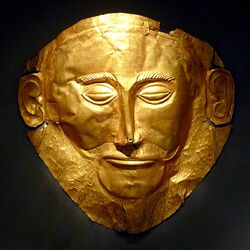| Mask of Agamemnon | |
|---|---|

| |
| "So this is not Agamemnon ... these are not his ornaments? All right, let's call him Schulze.” | |
|
Origin |
King Agamemnon |
|
Type |
Golden Funeral Mask |
|
Effects |
Face-Swapping |
|
Downsides |
Time and Location Desensitization |
|
Activation |
Wearing |
|
Collected by |
Warehouse 12]] |
|
Section |
|
|
Aisle |
836249-6820 |
|
Shelf |
963950-7839-597 |
|
Date of Collection |
March 30, 1897 |
| [Source] | |
Discovery[]
One of the greatest discoveries Heinrich Schliemann (6 January 1822 – 26 December 1890) ever made was the fabled historical site of Troy from the Illiad and Odyssey. Debates still rage on his methods, as he may have detonated the correctly aged layer of the city with dynamite during search efforts.
Another of his storied finds is the Mask of Agamemnon, a gold leafed funerary mask meant to adorn a Trojan War king. Discovered in a burial shaft in the ancient Greek city Mycenae, the mustachioed, wide-eared man stares vacantly outwards. Had Schliemann confirmed another legendary saga? Maybe not. The facial features don’t conform to the appearances of the other four masks found on site. (Schliemann had a reputation of “enhancing” certain artifacts, and knew a fair share of unscrupulous goldsmiths). Modern research dates the mask to the 1500s BC, a good four centuries before the war supposedly happened. Which raises the question who could possibly be depicted in the mask.
Agamemnon in the Trojan War[]
As a warrior, Agamemnon was known for his ferocious warpath without the need of favors from the gods, standing alongside Achilles in destruction. Multiple plays agree Agamemnon was somehow struck with misfortune on his way to Troy, probably from gloating over Artemis. The only way to restart the sailing winds was sacrificing his daughter Iphigenia. After the Greeks won, Agamemnon claimed a new daughter from Priam, Cassandra, to compensate his loss. Little did he know his wife at home already found another lover, and was furious about the killing of Iphigenia. She either directly committed or convinced her new beau to kill them both over her unbridled hatred for their actions.
Effects[]
Due to the confusing identity debate, the mask seems to have taken that ability in stride. The wearer can transform their face into anybody else at will, with any combination of features desired. It cannot alter the rest of their body though, leaving them physically the same as before.
Severs the user’s perception of normal time. They will have difficulty keeping proper track of hours, often confusing together different events in the wrong order. To them, buttering your toast comes after you’ve eaten it but before growing it. Also affects spatial awareness, making them unable to tell apart locations. Sewer drains start to look a lot like revolving doors, and elevation changes suddenly become meaningless.
Collection[]
It was one of the main displays at the National Archaeological Museum in Athens, but was collected early in the museum’s opening. When the newest curator mishandled the mask, it transformed him into one of the excavation workers. Naturally, security evicted someone they saw in squalor and dirt playing sticky fingers with their cultural heritage.
Our monsieur tried to smooth things out by entering the administration office to explain his identity. Given the man’s confusion, he instead entered a police station at three a.m. and was detained upon madness. Reports of possible duplicates walking around priceless artifacts piqued the Warehouse’s interest. They found the Mask and bagged it, with the update a university scholar had been released from the neighboring prison.
